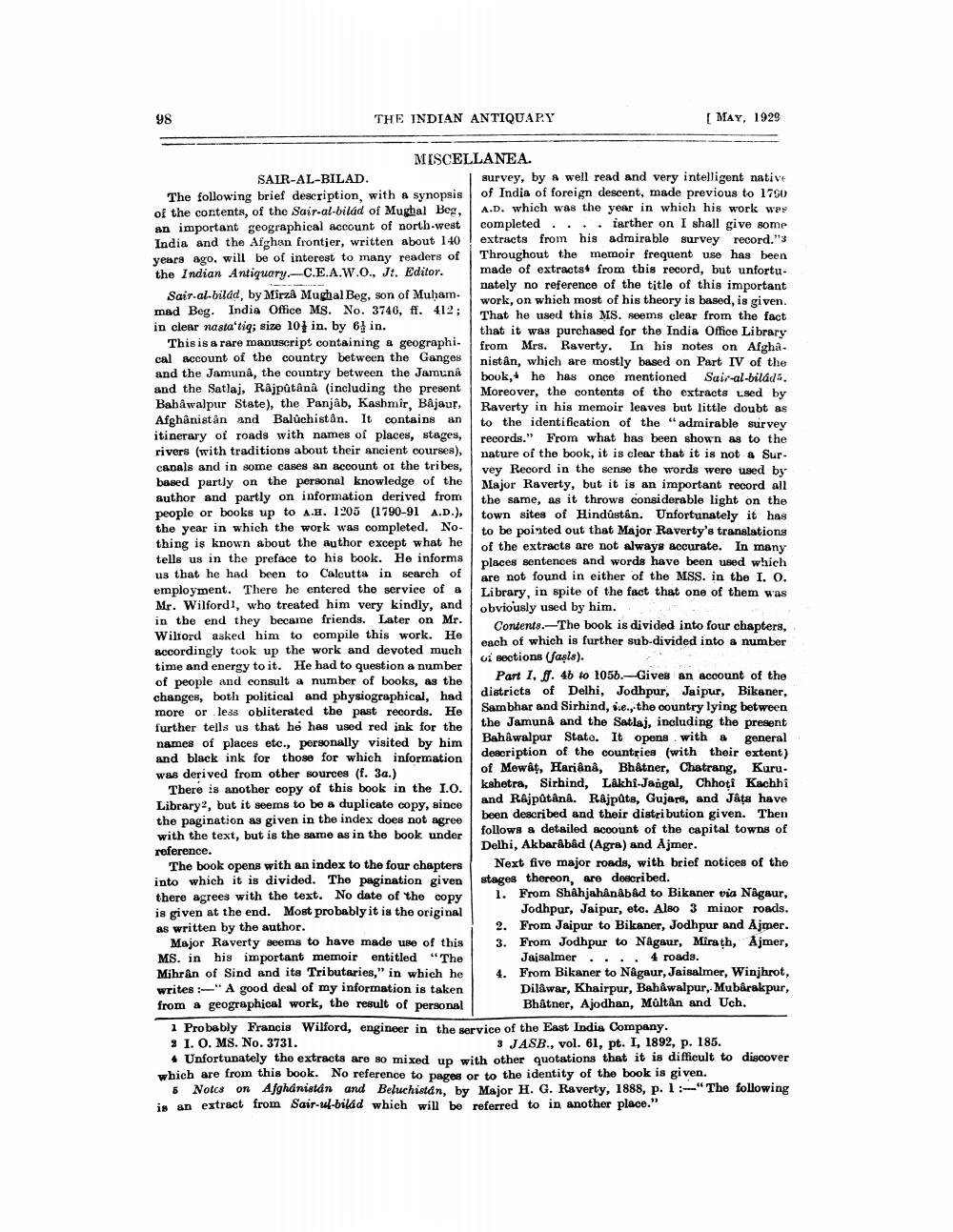________________
98
THE INDIAN ANTIQUAPY
[ MAY, 1929
MISCELLANEA. SAIR-AL-BILAD.
| survey, by A well read and very intelligent native The following brief description, with a synopsis of India of foreign descent, made previous to 1750 of the contents, of the Sair-al-bilad of Mughal Beg, A.D. which was the year in which his work was an important geographical account of north-west completed .... farther on I shall give some India and the Afghan frontier, written about 140 extracts from his admirable survey record." years ago, will be of interest to many readers of Throughout the memoir frequent use has been the Indian Antiquary.-C.E.A.W.O., J. Editor. made of extracts from this record, but unfortu
nately no reference of the title of this important Sair-al-bilad, by Mirza Mughal Beg, son of Muham.
work, on which most of his theory is based, is given. mad Beg. India Office MS. No. 3746, ff. 412;
That he used this MS. seems clear from the fact in clear nasta'tiq; size 101 in. by 6! in.
that it was purchased for the India Office Library This is a rare manuscript containing a geographi. from Mrs. Raverty. In his notes on Afgha. cal account of the country between the Ganges
nistân, which are mostly based on Part IV of the and the Jamuna, the country between the Jamuna
book, he has once mentioned Sair-al-biláds. and the Satlaj, Rajputânî (including the present Moreover, the contents of the extracts used by Bahåwalpur State), the Panjab, Kashmir, Båjaur, Raverty in his memoir leaves but little doubt as Afghanistan and Baluchistån. It contains an to the identification of the "admirable survey itinerary of roads with names of places, stages,
records." From what has been shown as to the rivers (with traditions about their ancient courses),
nature of the book, it is clear that it is not a Sur. cabals and in some cases an account of the tribes,
vey Record in the sense the words were used by based partly on the personal knowledge of the
Major Raverty, but it is an important record all author and partly on information derived from the same, as it throws considerable light on the people or books up to A.H. 1205 (1790-91 A.D.), town sites of Hindustan. Unfortunately it has the year in which the work was completed. No
to be pointed out that Major Raverty's translations thing is known about the author except what he
of the extracts are not always accurate. In many tells us in the preface to his book. He informs
places sentences and words have been used which us that he had been to Calcutta in search of
are not found in either of the MSS. in the I. 0. employment. There he entered the service of a Library, in spite of the fact that one of them was Mr. Wilford], who treated him very kindly, and obviously used by him.. in the end they became friends. Later on Mr.
Contents. The book is divided into four chapters, Wilford asked him to compile this work. He
each of which is further sub-divided into a number accordingly took up the work and devoted much
di sections (faşls). time and energy to it. He had to question a number
Part I, f. 4b to 1050.-Gives an account of the of people and consult a number of books, as the changes, both political and physiographical, had
districts of Delhi, Jodhpur, Jaipur, Bikaner, more or les obliterated the past records. He
Sambhar and Sirhind, i.e., the country lying between further tells us that he has used red ink for the
the Jamuna and the Satlaj, including the present names of places etc., personally visited by him
Bahawalpur State. It opens with a general and black ink for those for which information
description of the countries (with their extent) was derived from other sources (f. 3a.)
of Mewat, Hariana, Bhåtner, Chatrang, KuruThere is another copy of this book in the 1.0.
kshetra, Sirhind, Låkhi-Jangal, Chhoti Kachhi
and Rajputânå. Rajputs, Gujars, and Jâts have Library, but it seems to be a duplicate copy, since the pagination as given in the index does not agree
been described and their distribution given. Then with the text, but is the same as in the book under
follows a detailed account of the capital towns of reference.
Delhi, Akbarâbâd (Agra) and Ajmer. The book opens with an index to the four chapters
Next five major roads, with brief notices of the into which it is divided. The pagination given stages thereon, are described. there agrees with the text. No date of the copy 1. From Shahjahånåbåd to Bikaner via Nagaur, is given at the end. Most probably it is the original Jodhpur, Jaipur, etc. Also 3 minor roads. as written by the author.
2. From Jaipur to Bikaner, Jodhpur and Ajmer. Major Raverty seems to have made use of this 3. From Jodhpur to Någaur, Mirath, Ajmer, MS. in his important memoir entitled "The
Jaisalmer.... 4 roads. Mihran of Sind and its Tributaries," in which he 4. From Bikaner to Nagaur, Jaisalmer, Winjhrot, writes "A good deal of my information is taken
Dilawar, Khairpur, Bahåwalpur, Mubarakpur, from a geographical work, the result of personal
Bhâtner, Ajodhan, Multan and Uch. 1 Probably Francis Wilford, engineer in the service of the East India Company. 9 I. O. MS. No. 3731.
3 JASB., vol. 61, pt. I, 1892, p. 185. 4 Unfortunately the extracts are so mixed up with other quotations that it is difficult to discover which are from this book. No reference to pages or to the identity of the book is given.
6 Notcs on Afghanistan and Beluchistan, by Major H. G. Raverty, 1888, p. "The following is an extract from Sair-ul-bilad which will be referred to in another place."




